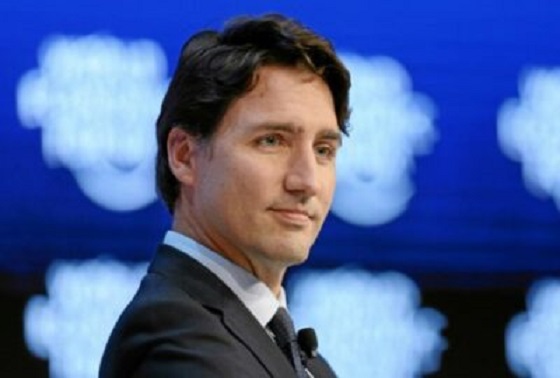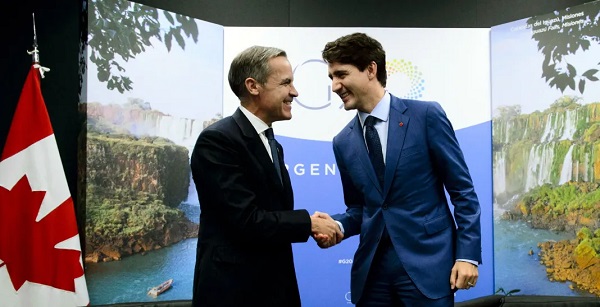Energy
Canadian Gas Association Writes a Letter to Prime Minister Justin Trudeau Highlighting the Importance of Natural Gas Energy Choice for Canadians

From EnergyNow.ca
On January 29, 2024, the Canadian Gas Association (CGA) sent a letter to Prime Minister Justin Trudeau, emphasizing the significance of the natural gas energy option for Canadians, a need underscored by the recent severe weather conditions in Western Canada.
The letter reads as follows:
Canada’s energy delivery companies had their work cut out for them over the last few weeks, ensuring the country could get through a period of extreme cold temperatures. The polar vortex that locked in across the continent only underscored how important an energy system with many options is to our overall well-being. I thought I would expand on this point in my first letter to you in 2024.
The second week of January saw temperatures in parts of the country drop well into the minus 40s, with windchill in the minus 50s. This triggered alerts from various authorities to reduce electricity use. Around 4 pm in Alberta on January 12th wind and solar generation facilities were operating at only a few percentage points of their capacity. But power was desperately needed. Luckily, a combination of in-province and neighbouring jurisdiction power sources – like natural gas-powered plants – could help meet the power needs of the province.
It is worth drawing attention to the fact that the alerts were all about a single energy system – the electricity grid. While that grid was under strain due in part to low renewable energy generation availability, the natural gas delivery system (a separate system that delivers gas energy, not electrons) was delivering approximately 9 times the energy and operating without any alerts required.
The contribution of the gas system is really worth emphasizing.
Nationally, over an average year, electricity meets just over 20% of our energy needs. Natural gas directly delivered to customers – residential, commercial and industrial – meets almost twice that amount, or just under 40% and liquid fuels like gasoline and diesel meet the balance. But at certain times of the year, such as during the recent January freeze, the differential between what natural gas and electricity deliver grows dramatically. At points earlier this month Alberta had use of roughly 12,000 megawatts of electric power and over 110,000 megawatts of gas energy equivalent.
And yet it was the electric system, not the natural gas system, that was threatened.
Media coverage during and after the freeze referenced how the electric system is threatened by extreme weather and needs to be built out to meet demand. But to suggest that the electric system could ever meet the energy delivered by natural gas over the gas delivery system is simply unrealistic. Do those who advocate for the electrification of all energy, especially peak heating needs, pretend that we have either the means, the resources, or the dollars, to build out an electric system that could meet roughly nine times the load of the gas system? Do advocates of natural gas bans appreciate that banning natural gas power generation would leave us in situations of actual shortage – a terrifying spectacle in the event of minus 50 degree weather?
Again, the point here is to underscore the value proposition of natural gas and the infrastructure that delivers it: the reliability these provide is extraordinarily important. This value is particularly well demonstrated when severe weather – a Canadian reality – hits us. We have to stop talking about eliminating the choice of energy options like natural gas, and relying exclusively on one energy delivery system, like electricity. Each delivery system has its own advantages, and natural gas is particularly well suited to meet heating needs. That should never be overlooked, as this month’s weather events reminded us.
Prime Minister, when it comes to energy – in supply options, and in delivery systems – diversity truly is our strength in Canada. We must maintain natural gas as an option for reliability, for affordability, and for sustainability – all of which are essential for our country’s energy security and the wellbeing of the Canadian consumer.
Respectfully,
Timothy M. Egan
President and CEO, Canadian Gas Association
Chair, NGIF Capital Corporation
About CGA
The Canadian Gas Association (CGA) is the voice of Canada’s gaseous energy delivery industry, including natural gas, renewable natural gas (RNG) and hydrogen. CGA membership includes energy distribution and transmission companies, equipment manufacturers, and suppliers of goods and services to the industry. CGA’s utility members are Canadian-owned and active in eight provinces and one territory. The Canadian natural gas delivery industry meets 38 per cent of Canada’s energy needs through a network of almost 584,000 kilometers of underground infrastructure. The versatility and resiliency of this infrastructure allows it to deliver an ever-changing gas supply mix to 7.6 million customer locations representing approximately two-thirds of Canadians. CGA members ensure Canadians get the affordable, reliable, clean gaseous energy they want and need. CGA is also working to constantly improve that gaseous energy offering, by driving forward innovation through the Natural Gas Innovation Fund (NGIF).
SOURCE Canadian Gas Association
Business
Climate Climbdown: Sacrificing the Canadian Economy for Net-Zero Goals Others Are Abandoning

By Gwyn Morgan
Canada has spent the past decade pursuing climate policies that promised environmental transformation but delivered economic decline. Ottawa’s fixation on net-zero targets – first under Justin Trudeau and now under Prime Minister Mark Carney – has meant staggering public expenditures, resource project cancellations and rising energy costs, all while failing to
reduce the country’s dependence on fossil fuels. Now, as key international actors reassess the net-zero doctrine, Canada stands increasingly alone in imposing heavy burdens for negligible gains.
The Trudeau government launched its agenda in 2015 by signing the Paris Climate Agreement aimed at limiting the forecast increase in global average temperature to 1.5°C by the end of the century. It followed the next year with the Pan-Canadian Framework on Clean Growth and Climate Change that imposed more than 50 measures on the economy, key among them a
carbon “pricing” regime – Liberal-speak for taxes on every Canadian citizen and industry. Then came the 2030 Emissions Reduction Plan, committing Canada to cut greenhouse gas emissions to 40 percent below 2005 levels by 2030, and to achieve net-zero by 2050. And then the “On-Farm Climate Action Fund,” the “Green and Inclusive Community Buildings Program” and the “Green Municipal Fund.”
It’s a staggering list of nation-impoverishing subsidies, taxes and restrictions, made worse by regulatory measures that hammered the energy industry. The Trudeau government cancelled the fully-permitted Northern Gateway pipeline, killing more than $1 billion in private investment and stranding hundreds of billions of dollars’ worth of crude oil in the ground. The
Energy East project collapsed after Ottawa declined to challenge Quebec’s political obstruction, cutting off a route that could have supplied Atlantic refineries and European markets. Natural gas developers fared no better: 11 of 12 proposed liquefied natural gas export terminals were abandoned amid federal regulatory delays and policy uncertainty. Only a single LNG project in Kitimat, B.C., survived.
None of this has had the desired effect. Between Trudeau’s election in 2015 and 2023, fossil fuels’ share of Canada’s energy supply actually increased from 75 to 77 percent. As for saving the world, or even making some contribution towards doing so, Canada contributes just 1.5 percent of global GHG emissions. If our emissions went to zero tomorrow, the emissions
growth from China and India would make that up in just a few weeks.
And this green fixation has been massively expensive. Two newly released studies by the Fraser Institute found that Ottawa and the four biggest provinces have either spent or foregone a mind-numbing $158 billion to create just 68,000 “clean” jobs – an eye-watering cost of over $2.3 million per job “created”. At that, the green economy’s share of GDP crept up only 0.3
percentage points.
The rest of the world is waking up to this folly. A decade after the Paris Agreement, over 81 percent of the world’s energy still comes from fossil fuels. Environmental statistician and author Bjorn Lomborg points out that achieving global net-zero by 2050 would require removing the equivalent of the combined emissions of China and the United States in each of the next five
years. “This puts us in the realm of science fiction,” he wrote recently.
In July, the U.S. Department of Energy released a major assessment assembled by a team of highly credible climate scientists which asserted that “CO 2 -induced warming appears to be less damaging economically than commonly believed,” and that aggressive mitigation policies might be “more detrimental than beneficial.” The report found no evidence of rising frequency or severity of hurricanes, floods, droughts or tornadoes in U.S. historical data, while noting that U.S. emissions reductions would have “undetectably small impacts” on global temperatures in any case.
U.S. Energy Secretary Chris Wright welcomed the findings, noting that improving living standards depends on reliable, affordable energy. The same day, the Environmental Protection Agency proposed rescinding the 2009 “endangerment finding” that had designated CO₂ and other GHGs as “pollutants.” It had led to sweeping restrictions on oil and gas development and fuelled policies that the current administration estimates cost the U.S. economy at least US$1 trillion in lost growth.
Even long-time climate alarmists are backtracking. Ted Nordhaus, a prominent American critic, recently acknowledged that the dire global warming scenarios used by the Intergovernmental Panel on Climate Change rely on implausible combinations of rapid population growth, strong economic expansion and stagnant technology. Economic growth typically reduces population increases and accelerates technological improvement, he pointed out, meaning emissions trends will likely be lower than predicted. Even Bill Gates has tempered his outlook, writing that climate change will not be “cataclysmic,” and that although it will hurt the poor, “it will not be the only or even the biggest threat to their lives and welfare.” Poverty and disease pose far greater threats and resources, he wrote, should be focused where they can do the most good now.
Yet Ottawa remains unmoved. Prime Minister Carney’s latest budget raises industrial carbon taxes to as much as $170 per tonne by 2030, increasing the competitive disadvantage of Canadian industries in a time of weak productivity and declining investment. These taxes will not measurably alter global emissions, but they will deepen Canada’s economic malaise and
push production – and emissions – toward jurisdictions with more lax standards. As others retreat from net-zero delusions, Canada moves further offside global energy policy trends – extending our country’s sad decline.
The original, full-length version of this article was recently published in C2C Journal.
Gwyn Morgan is a retired business leader who has been a director of five global corporations.
Carbon Tax
Carney fails to undo Trudeau’s devastating energy policies

From the Fraser Institute
By Tegan Hill and Elmira Aliakbari
On the campaign trail and after he became prime minister, Mark Carney has repeatedly promised to make Canada an “energy superpower.” But, as evidenced by its first budget, the Carney government has simply reaffirmed the failed plans of the past decade and embraced the damaging energy policies of the Trudeau government.
First, consider the Trudeau government’s policy legacy. There’s Bill C-69 (the “no pipelines act”), the new electricity regulations (which aim to phase out natural gas as a power source starting this year), Bill C-48 (which bans large oil tankers off British Columbia’s northern coast and limit Canadian exports to international markets), the cap on emissions only from the oil and gas sector (even though greenhouse gas emissions have the same effect on the environment regardless of the source), stricter regulations for methane emissions (again, impacting the oil and gas sector), and numerous “net-zero” policies.
According to a recent analysis, fully implementing these measures under Trudeau government’s emissions reduction plan would result in 164,000 job losses and shrink Canada’s economic output by 6.2 per cent by the end of the decade compared to a scenario where we don’t have these policies in effect. For Canadian workers, this will mean losing $6,700 (annually, on average) by 2030.
Unfortunately, the Carney government’s budget offers no retreat from these damaging policies. While Carney scrapped the consumer carbon tax, he plans to “strengthen” the carbon tax on industrial emitters and the cost will be passed along to everyday Canadians—so the carbon tax will still cost you, it just won’t be visible.
There’s also been a lot of buzz over the possible removal of the oil and gas emissions cap. But to be clear, the budget reads: “Effective carbon markets, enhanced oil and gas methane regulations, and the deployment at scale of technologies such as carbon capture and storage would create the circumstances whereby the oil and gas emissions cap would no longer be required as it would have marginal value in reducing emissions.” Put simply, the cap remains in place, and based on the budget, the government has no real plans to remove it.
Again, the cap singles out one source (the oil and gas sector) of carbon emissions, even when reducing emissions in other sectors may come at a lower cost. For example, suppose it costs $100 to reduce a tonne of emissions from the oil and gas sector, but in another sector, it costs only $25 a tonne. Why force emissions reductions in a single sector that may come at a higher cost? An emission is an emission regardless of were it comes from. Moreover, like all these policies, the cap will likely shrink the Canadian economy. According to a 2024 Deloitte study, from 2030 to 2040, the cap will shrink the Canadian economy (measured by inflation-adjusted GDP) by $280 billion, and result in lower wages, job losses and a decline in tax revenue.
At the same time, the Carney government plans to continue to throw money at a range of “green” spending and tax initiatives. But since 2014, the combined spending and forgone revenue (due to tax credits, etc.) by Ottawa and provincial governments in Ontario, Quebec, British Columbia and Alberta totals at least $158 billion to promote the so-called “green economy.” Yet despite this massive spending, the green sector’s contribution to Canada’s economy has barely changed, from 3.1 per cent of Canada’s economic output in 2014 to 3.6 per cent in 2023.
In his first budget, Prime Minister Carney largely stuck to the Trudeau government playbook on energy and climate policy. Ottawa will continue to funnel taxpayer dollars to the “green economy” while restricting the oil and gas sector and hamstringing Canada’s economic potential. So much for becoming an energy superpower.
-

 Alberta2 days ago
Alberta2 days agoNational Crisis Approaching Due To The Carney Government’s Centrally Planned Green Economy
-

 Carbon Tax1 day ago
Carbon Tax1 day agoCarney fails to undo Trudeau’s devastating energy policies
-

 Business1 day ago
Business1 day agoThe UN Pushing Carbon Taxes, Punishing Prosperity, And Promoting Poverty
-

 Agriculture2 days ago
Agriculture2 days agoFederal cabinet calls for Canadian bank used primarily by white farmers to be more diverse
-

 Health1 day ago
Health1 day agoNEW STUDY: Infant Vaccine “Intensity” Strongly Predicts Autism Rates Worldwide
-

 Business1 day ago
Business1 day agoClimate Climbdown: Sacrificing the Canadian Economy for Net-Zero Goals Others Are Abandoning
-

 Great Reset2 days ago
Great Reset2 days agoCanadian government forcing doctors to promote euthanasia to patients: report
-

 Artificial Intelligence23 hours ago
Artificial Intelligence23 hours agoLawsuit Claims Google Secretly Used Gemini AI to Scan Private Gmail and Chat Data


